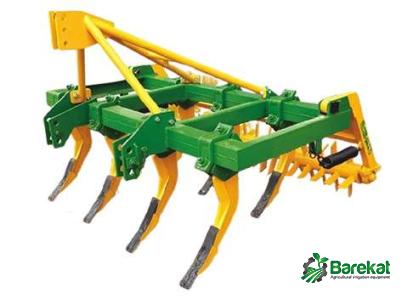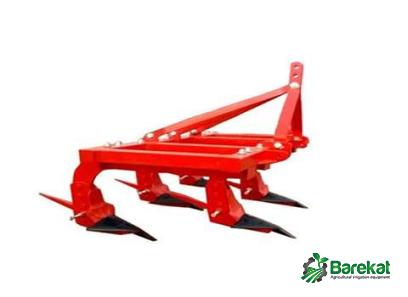In the ever-evolving world of agriculture, staying ahead of the game is the key to success. As farmers strive to increase productivity while also preserving soil health, the use of innovative tools becomes essential. One such tool that has gained significant popularity in recent years is the chisel plough. This article explores the benefits and features of the chisel plough and how it can help farmers achieve their agricultural goals. 1. Maximizing Soil Health: A chisel plough is specifically designed to minimize soil disturbance while effectively breaking up compacted soil layers. By doing so, it helps improve soil aeration, infiltration, and drainage, crucial for root development and plant growth.

.
 With reduced soil disturbance, the chisel plough enables farmers to maintain essential soil structure, organic matter, and microbial activity, leading to healthier and more productive land. 2. Weed Control and Residue Management: Chisel ploughs are adept at managing weeds and crop residue. Equipped with multiple shanks or tines, the chisel plough breaks up crop residues and incorporates them into the soil, effectively disrupting weed growth and reducing the need for herbicides. Additionally, the chisel plough’s ability to bury crop residues promotes decomposition, releasing essential nutrients back into the soil, and creating a fertile seedbed for the next crop. 3. Precision and Versatility: Unlike traditional ploughs that invert the soil, a chisel plough operates at various depths without turning over the soil.
With reduced soil disturbance, the chisel plough enables farmers to maintain essential soil structure, organic matter, and microbial activity, leading to healthier and more productive land. 2. Weed Control and Residue Management: Chisel ploughs are adept at managing weeds and crop residue. Equipped with multiple shanks or tines, the chisel plough breaks up crop residues and incorporates them into the soil, effectively disrupting weed growth and reducing the need for herbicides. Additionally, the chisel plough’s ability to bury crop residues promotes decomposition, releasing essential nutrients back into the soil, and creating a fertile seedbed for the next crop. 3. Precision and Versatility: Unlike traditional ploughs that invert the soil, a chisel plough operates at various depths without turning over the soil.
..
 This versatility allows farmers to adjust the depth of their tillage operations based on soil conditions, crop type, and farming goals. Whether it’s shallow tillage for seedbed preparation or deeper tillage for managing compaction layers, chisel ploughs offer precise control over soil tillage, leading to more efficient operations and improved crop performance. 4. Conservation and Sustainability: With a growing emphasis on sustainable farming practices, the chisel plough has become an integral tool for conservation agriculture. By minimizing soil disturbance, the chisel plough reduces soil erosion, preserving valuable topsoil and preventing sediment runoff into water bodies. With reduced tillage requirements, farmers can also conserve energy, reduce fuel costs, and contribute to carbon sequestration by maintaining organic matter levels in the soil. 5. Increased Efficiency and Cost Savings: The chisel plough’s ability to perform multiple operations in one pass, such as tillage, residue incorporation, and deeper compaction relief, saves time and labor costs.
This versatility allows farmers to adjust the depth of their tillage operations based on soil conditions, crop type, and farming goals. Whether it’s shallow tillage for seedbed preparation or deeper tillage for managing compaction layers, chisel ploughs offer precise control over soil tillage, leading to more efficient operations and improved crop performance. 4. Conservation and Sustainability: With a growing emphasis on sustainable farming practices, the chisel plough has become an integral tool for conservation agriculture. By minimizing soil disturbance, the chisel plough reduces soil erosion, preserving valuable topsoil and preventing sediment runoff into water bodies. With reduced tillage requirements, farmers can also conserve energy, reduce fuel costs, and contribute to carbon sequestration by maintaining organic matter levels in the soil. 5. Increased Efficiency and Cost Savings: The chisel plough’s ability to perform multiple operations in one pass, such as tillage, residue incorporation, and deeper compaction relief, saves time and labor costs.
…
 Moreover, by promoting optimal soil conditions, the chisel plough contributes to improved plant root development, thus enhancing nutrient uptake and overall crop yield. Ultimately, this increased efficiency translates to higher profits for farmers. Conclusion: As farmers face the ever-growing challenge of increasing agricultural productivity sustainably, the chisel plough emerges as a valuable tool. With its ability to improve soil health, manage weeds, and conserve resources, the chisel plough offers a win-win solution for both farmers and the environment. Embracing this innovative technology is a step toward more efficient and sustainable farming practices, paving the way for a brighter future in agriculture.
Moreover, by promoting optimal soil conditions, the chisel plough contributes to improved plant root development, thus enhancing nutrient uptake and overall crop yield. Ultimately, this increased efficiency translates to higher profits for farmers. Conclusion: As farmers face the ever-growing challenge of increasing agricultural productivity sustainably, the chisel plough emerges as a valuable tool. With its ability to improve soil health, manage weeds, and conserve resources, the chisel plough offers a win-win solution for both farmers and the environment. Embracing this innovative technology is a step toward more efficient and sustainable farming practices, paving the way for a brighter future in agriculture.










Your comment submitted.